Iconic Chairs of the 20th Century
By: James Wilder
An introduction and reference for iconic mid century modern chairs.
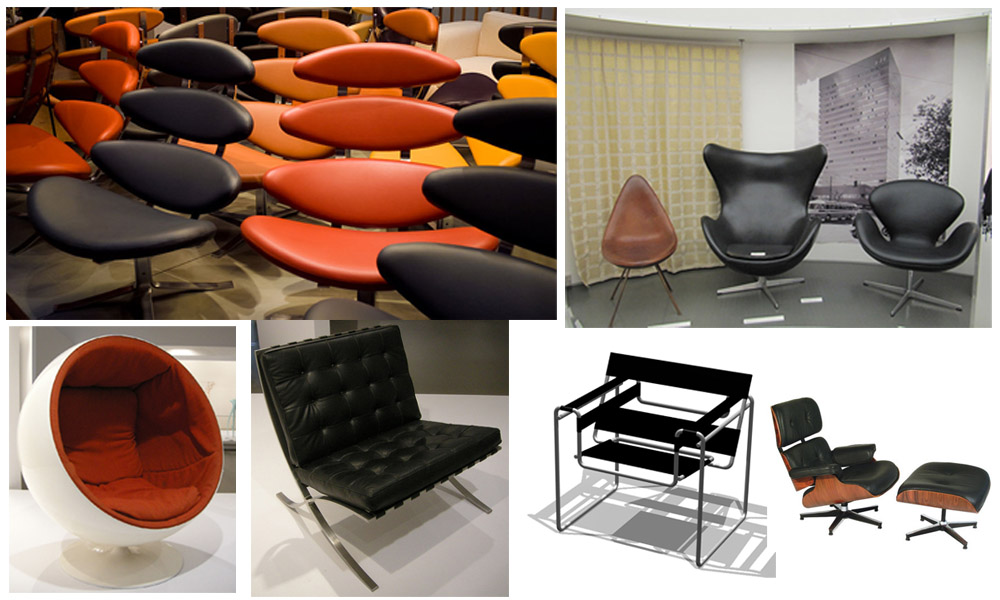
Introduction
Much of the modern furniture designs today are replicas of, or inspired by, classic modern chairs of the 20th century.
This modern chair guide will help you:
- Learn to identify the famous modern chairs of the 20th century.
- Help you distinguish between original and "similar" designs.
- Get a brief introduction to modern design.
These iconic modern chairs are listed in order starting with the most recent to the earliest modern chairs.
Last Update: 5-1-2023
Ball Chair by Eero Aarnio
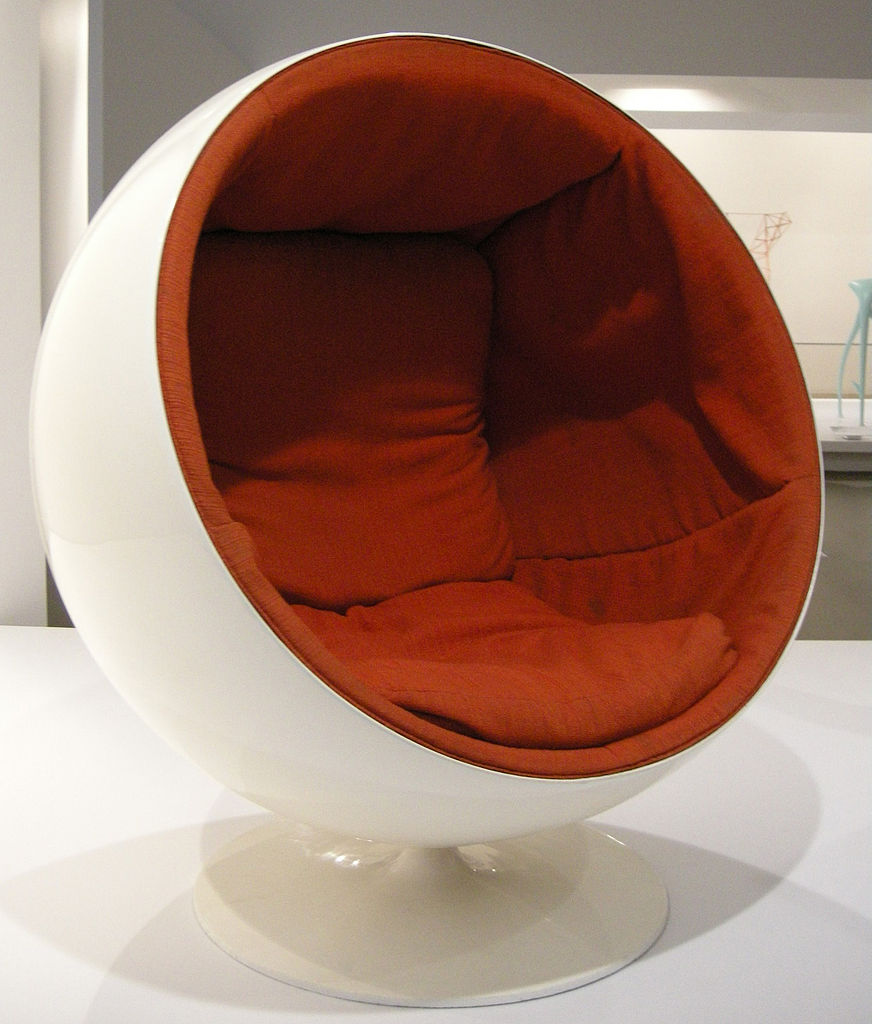
Ball Chair by Eero Aarnio. Credit: I, Sailko [CC BY-SA 3.0 (creativecommons.org/licenses/by-sa/3.0/)]
The Ball Chair was designed by Finnish furniture designer Eero Aarnio in 1963.
He designed the chair for himself. It wasn't until years later that the chair made its debut at the 1966 Cologne Furniture Fair in Germany.
"At a time when sober clean lines and angles were the order of the day, Eero bent the rules and rounded the corners." -aarniooriginals.com
Eero Aarnio was born July 21, 1932, in Helsinki, Finland and is still designing today.
Eero Aarnio's designs can be found at www.aarniooriginals.com and reproductions are easily available from other manufacturers.
Egg Chair by Arne Jacobsen
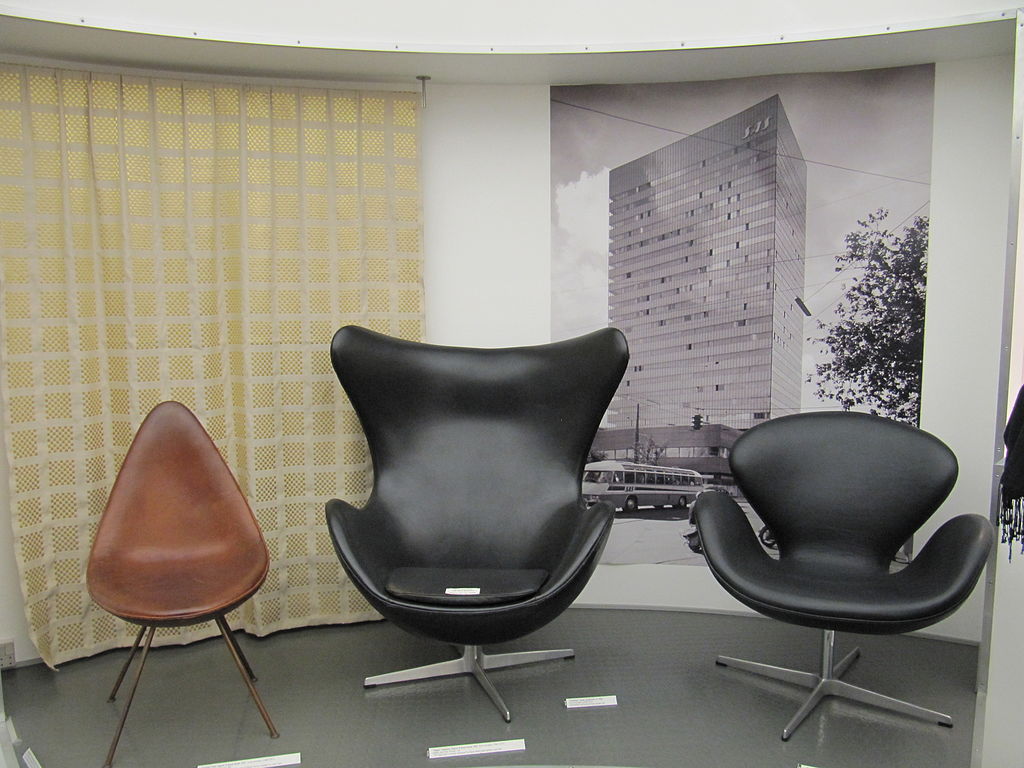
Egg Chair by Arne Jacobsen. Credit: lglazier618 [CC BY 2.0 (creativecommons.org/licenses/by/2.0)]
Arne Jacobsen, born on February 11, 1902, was a Danish architect and designer.
Arne Jacobsen recieved a commision to design the SAS Royal Hotel, in Copenhagen, Denmark. This commission allowed him to have creative design control not only of the hotel building but also the furniture, cutlery, glassware, door handles, candlesticks and even the ashtrays sold in the souvenir shop.
Jacobsen designed the Egg™ chair in 1958, as well as the Swan chair, Swan sofa, and Drop chair, for the lobby and reception area of the hotel.
It is said that the SAS Hotel was the first designer hotel.
The SAS Royal Hotel opened on July 1, 1960.
Corona Chair by Poul M. Volther
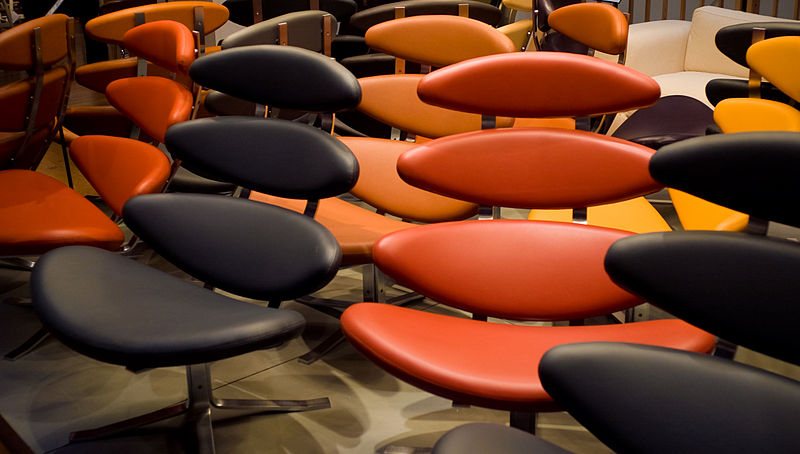
Corona Chair by Poul M. Volther. Credit: Lars Plougmann from United States [CC BY-SA 2.0 (creativecommons.org/licenses/by-sa/2.0)]
Poul M. Volther, born on January 2, 1923, was a Danish furniture designer and creator of the Corona Chair.
The success of the Corona Chair was far from overnight.
The intent of the original design was to have several smaller cushions. This was due to the lack of materials following World War II. The frame also started out as wood.
The first model, called the Pyramid Chair, was introduced in 1953. However it was not a wild success.
The design continued to evolve and the Corona Chair was introduced in 1961. This design still used wood.
In 1962, Volther worked with the Erik Jørgensen furniture factory to create a new model with a chrome-plated steel frame. The new model was introduced in 1964. But it was still far from successful.
Some twenty years later, another variant was shown at the Furniture Fair in Cologne. It received good press, but it still didn't sell well.
Finally, in 1997, the chair was shown at the Cologne Furniture Fair and the Scandinavian Furniture Fair at the Bella Center in Copenhagen. This time the chair was a success.
You can check out Poul Volther's designs at this site. The wooden version of the Corona Chair is very impressive as well.
erik-joergensen.com/en/designer/poul-m-volther
Wing Chair by Hans Wegner
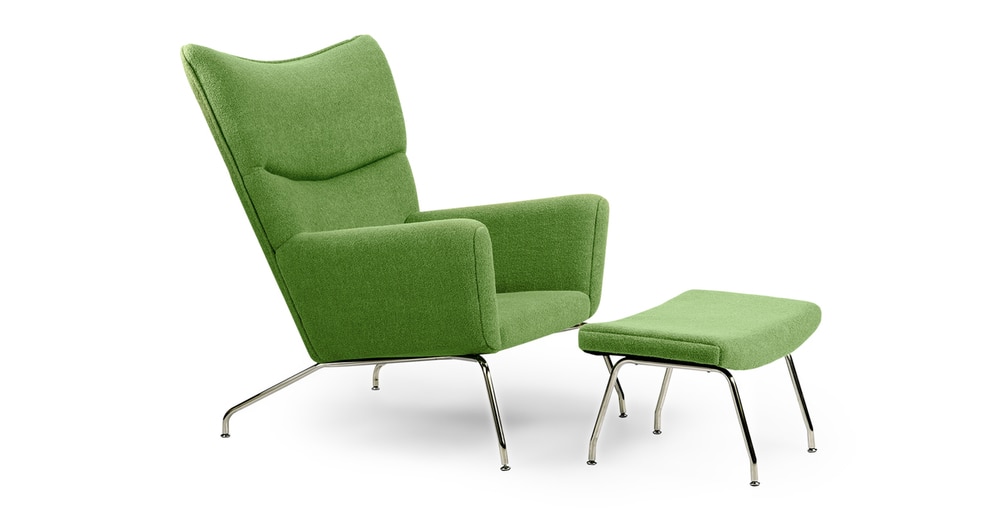
Wing Chair by Hans Wegner.
The Wing Chair was designed by Hans Wegner in 1960.
Hans Jørgensen Wegner, born on April 2, 1914, was a Danish furniture designer.
The Wing Chair was originally produced in very limited numbers, but it was relaunched in 2006 based on Wegner’s original design.
The original design of this chair won an award at the 2006 International Furniture Fair in Cologne, 46 years after it was originally designed!
Wegner worked with Arne Jacobsen, designer of the Egg Chair, during much of his life.
Hans Wegner died on January 26, 2007. In his lifetime he designed over 500 different chairs, with over 100 put into mass production.
Out of all the chairs on this list, the Wing Chair is one of my personal favorites (meaning, I will buy one!).
Homework: Which Hans Wegner chair was a regular in the living room of the Bewitched TV show?
Eames Lounge Chair by Charles and Ray Eames
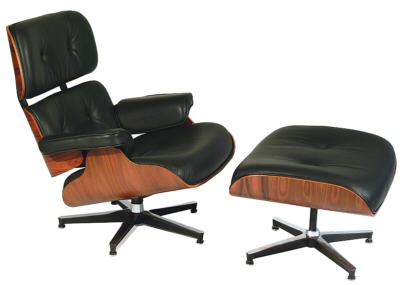
Eames Lounge Chair and ottoman by Charles and Ray Eames. Credit: Public Domain
The Eames Lounge Chair and ottoman were designed by Charles and Ray Eames for the Herman Miller furniture company.
The design of the Eames Lounge Chair was intended to be a lighter modern version of the traditional English Club Chair.
Charles and Ray Eames were an American married team of industrial designers. This dynamic couple made significant contributions to the development of modern architecture and furniture through the work of The Eames Office.
The Eames Lounge Chair debuted in 1956 after years of development. Since its introduction, the chair has been in continuous production by Herman Miller in America.
Harry Bertoia, creator of the Diamond Chair, worked with Charles and Ray Eames before his time at the equally famous Knoll, Inc.
Coconut Chair by George Nelson
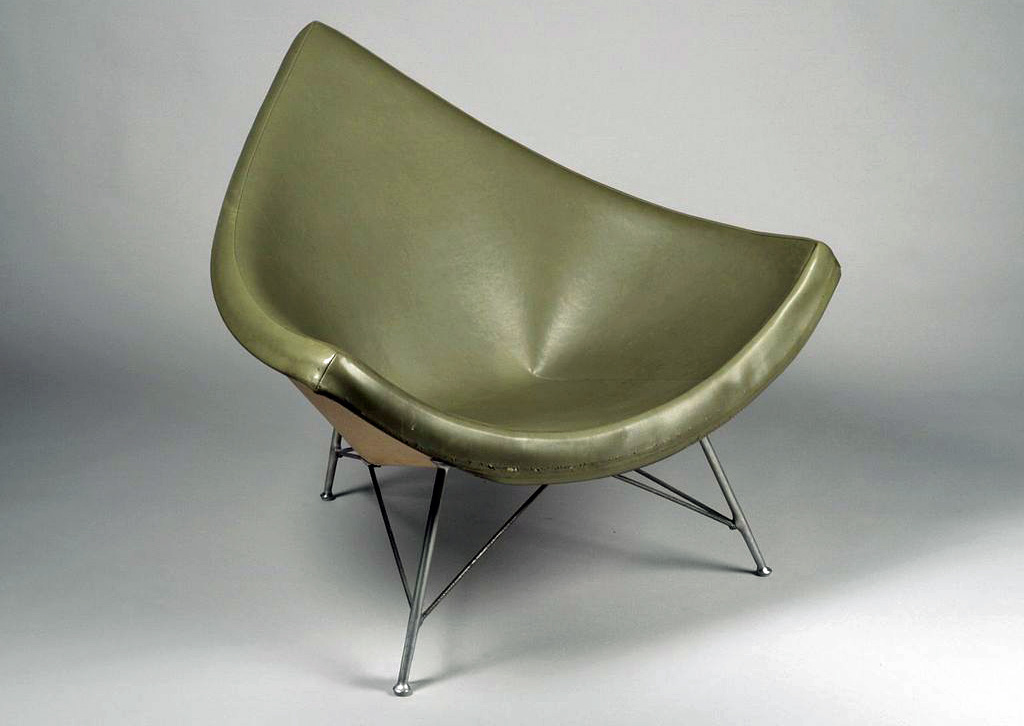
Nelson Coconut Chair. Produced by Herman Miller Furniture in 1955.
The Coconut Chair (Product Number: 5569) was produced by the Herman Miller Furniture Company in 1955. George Nelson and George Mulhauser were the designers of the Coconut Chair.
George Nelson was the director of design at Herman Miller and George Mulhauser was one of Nelson's designers.
While the Coconut Chair design is attributed to George Nelson, George Mulhauser was probably responsible for the design. George Mulhauser went on to design several famous mid century modern chairs of his own, which I will write about in the future.
Many articles on the web claim that the inspiration for the shape of the chair came from the Kresge Auditorium at MIT, designed by architect Eero Saarinen. Though there is a striking resemblance to the three point dome, I have not found any authoritative proof that links the two designs together.
Without a doubt, the name of the chair reveals the source of the design inspiration: the coconut!
George Nelson typically described the shape of the chair as a slice of coconut that had been divided up into eight sections.
A 1956 design statement reveals the goal of the Coconut Chair design: The Coconut Chair "was developed to give lounge seating comfort together with great freedom of movement. Many positions are possible in this chair with a maximum of comfort in every case." This design goal was very similar to the vision that Florence Knoll had for the Womb Chair, produced in 1948. It's possible that Herman Miller was positioning the Coconut Chair as a competitor to the Knoll Womb Chair.
The original chair design used a metal shell, which I’m sure was quite heavy. They switched to fiberglass resin when it was proven to be a suitable material for creating curvy products. Today the chair shell is made of plastic.
Herman Miller produced the Coconut Chair from 1955 to 1978. It was reintroduced in 2001 and is still in production today.
For more fascinating details, and where to buy, see my in-depth article Chair Story: The Nelson Coconut Chair.
Diamond Chair by Harry Bertoia
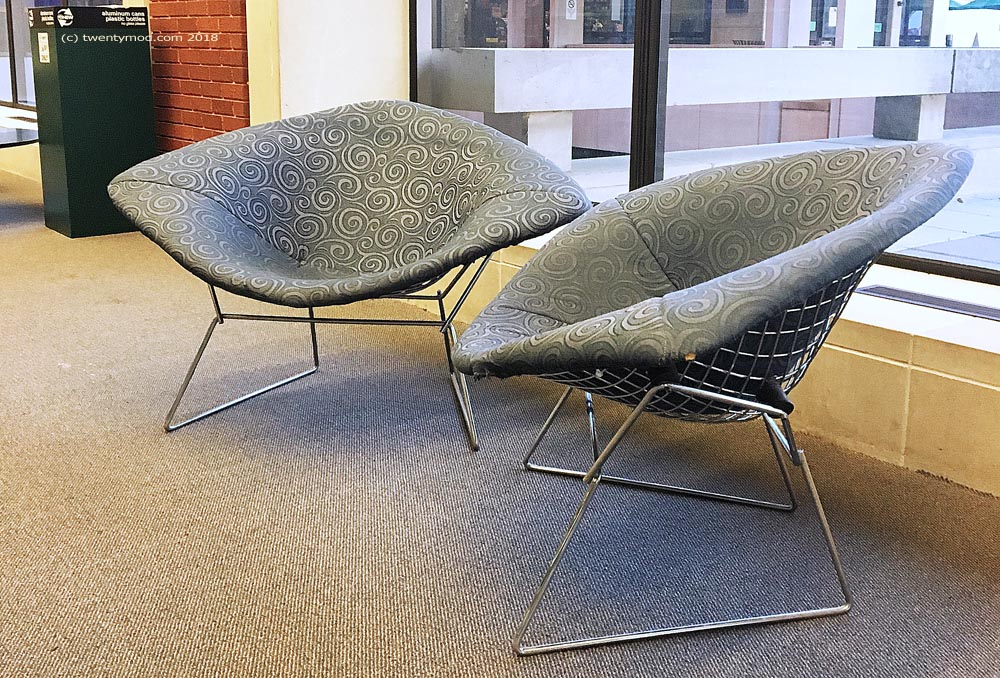
Diamond Chair by Harry Bertoia. Credit: James Wilder
The Diamond Chair was designed by Harry Bertoia and is manufactured by Knoll Inc.
Harry Bertoia was born on March 10, 1915 in San Lorenzo, Pordenone, Italy. At the age of fifteen, he migrated to the United States and lived in Detroit, Michigan with his brother.
Bertoia is known for his chair designs, but his first desire was for sculpture. The Diamond chair is first sculpture, then chair.
Bertoia designed five different wire furniture pieces and Knoll paid Bertoia handsomely for the rights to manufacture them. Knoll introduced the Diamond Chair in 1952 and began producing and selling them in 1953.
You could find the Bertoia Diamond Chair at the GM Design Center in the 1950s. It was even featured prominently in a photo with the new 1957 Cadillac design.
Womb Chair by Eero Saarinen
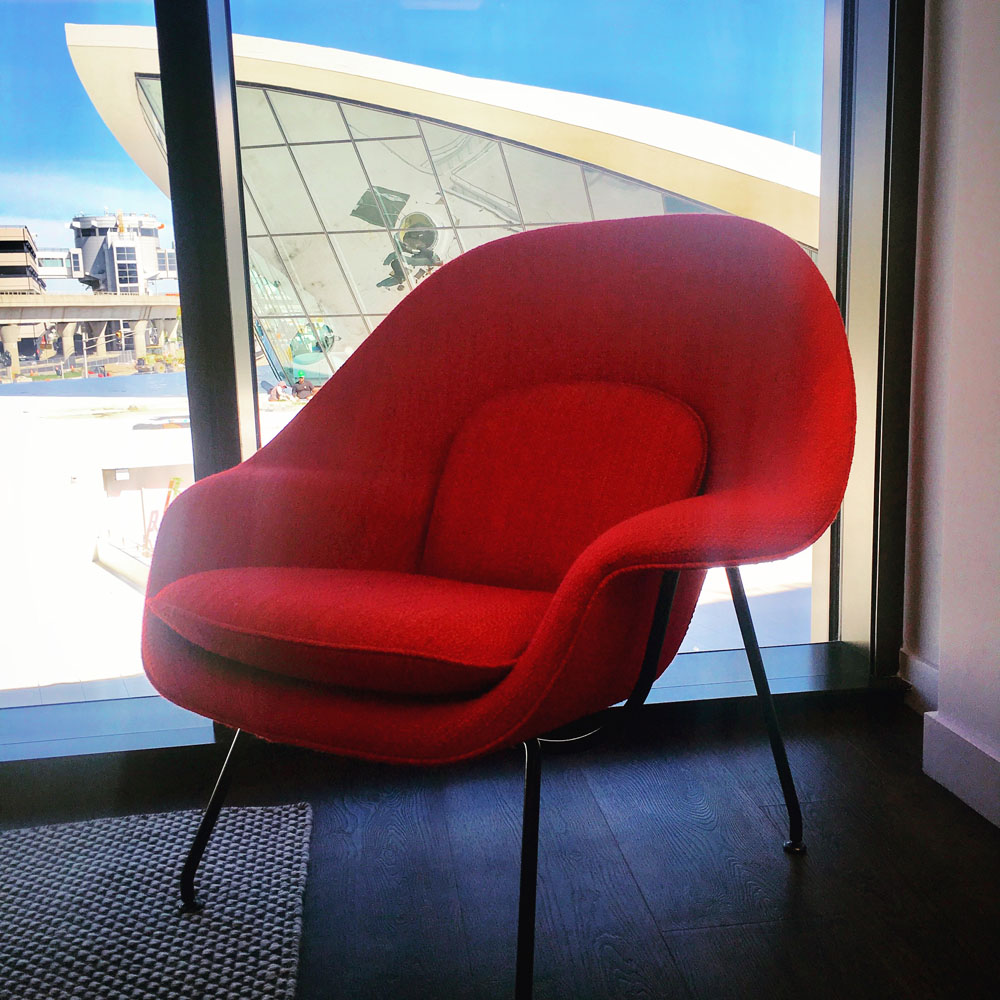
Womb Chair by Eero Saarinen. Credit: tsailer
The Womb Chair was designed by architect Eero Saarinen for Knoll, Inc. It was put into production by Knoll in 1948 and it’s still being produced today.
The vision for the womb chair came from Florence Knoll and she wanted her friend Eero Saarinen to make the vision a reality. She described the chair as something "like a great big basket of pillows that I can curl up in."
Based on the vision, the goal was fairly clear: create a comfortable chair that could accommodate various relaxed seating positions. This would include space for your legs on the chair.
These requirements led Saarinen to experiment with a new material that used sheets of fiberglass with a resin coating. This fiberglass resin technique was just beginning to be used by the boat and automotive industries, but had not been used for furniture design. After prototypes they came up with a design that would work, and the womb chair was born.
The Womb Chair became the first fiberglass chair to be mass-produced in America.
The Womb Chair quickly gained popularity and was featured in magazines and advertisements. In 1958, the Coca-Cola company created an advertisement with Santa Claus sitting in a Womb Chair sipping a refreshing bottle of Coca-Cola. In 1959, the Saturday Evening Post’s cover page was a Norman Rockwell painting of a man sitting in a Womb Chair while his wife and children were heading for church. Saturday Evening Post, published May 16, 1959.
Eero Saarinen continued to design furniture for Knoll, such as the "Womb" settee (1950), side and arm chairs (1948–1950), and his most famous "Tulip" or "Pedestal" group (1956), which featured side and arm chairs, dining, coffee and side tables, as well as a stool.
The same year Eero Saarinen’s Womb Chair went into production, he won a competition to design a memorial for the Jefferson National Expansion Memorial Park in St. Louis, Missouri. Saarinen's winning design was a massive arch, known today as the Gateway Arch of Gateway Arch National Park. Construction of the arch was completed in 1965.
Eero Saarinen’s Architectural works include the Gateway Arch in St. Louis, Missouri (1948. Completed in 1965), the Kresge Auditorium at MIT (1955), MIT Chapel (1956), the TWA Terminal at John F. Kennedy Airport, New York (1962).
Sadly, Eero Saarinen died on September 1, 1961 at the age of 51.
The good news is the TWA Terminal at John F. Kennedy Airport, designed by Eero Saarinen, was reopened as a hotel in 2019. The new TWA Hotel opened on May 15, 2019 and retains most of the amazing futuristic design, making the name Eero Saarinen known to a new generation.
So there you have it! If you own a Womb Chair, you have quite a story to tell!
The Womb Chair is not just a chair, it’s a tribute to the idea that an object of good design has value far beyond the object itself. And Florence Knoll's mantra was always "Good design is good business."
Barcelona Chair by Ludwig Mies van der Rohe
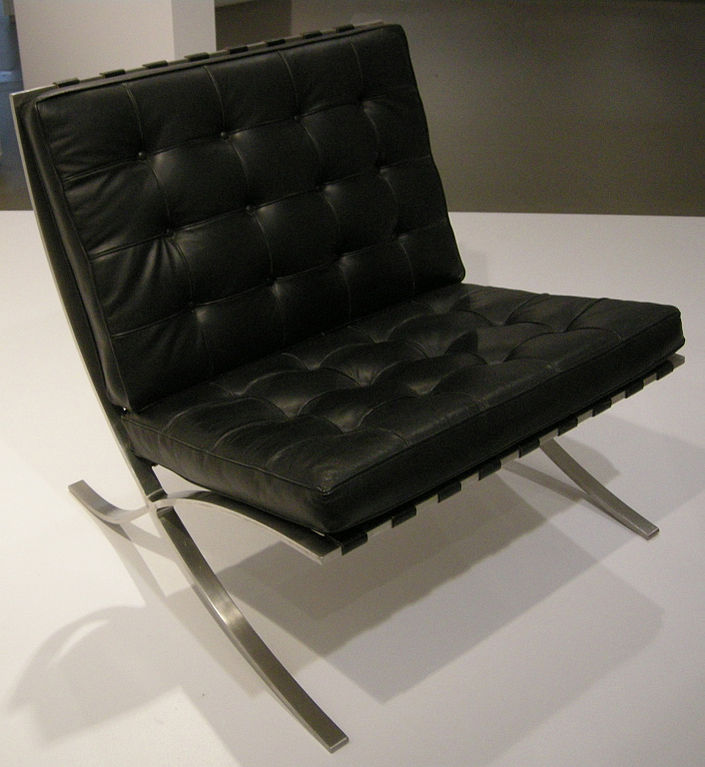
Barcelona Chair by Ludwig Mies van der Rohe. Credit: I, Sailko [CC BY-SA 3.0 (creativecommons.org/licenses/by-sa/3.0/)]
The Barcelona chair was designed by German Architect, Mies van der Rohe, in 1929.
The Barcelona chair was originally designed for the German Pavilion, that country's entry for the International Exposition of 1929, which was hosted in Barcelona, Spain.
1930 marked the first commercial production of the Barcelona Chair. Several companies have produced the chair throughout the decades.
Knoll Inc. began producing the chair in 1947, and is still in production today.
It is difficult to talk about the Barcelona chair without adding a few important details about Mies van der Rohe, and also mention Bauhaus.
The Bauhaus was founded in 1919 in the city of Weimar by German architect Walter Gropius (1883–1969). Bauhaus was a design and art school in Germany that specialized in modern design and manufacturing ideas. Mies van der Rohe was director of Bauhaus from 1930 to 1933.
The rise of Nazism in 1933 brought strong opposition to modernism and led to the closing of the Bauhaus.
With a bleak future in Germany, Mies moved to the United States. He accepted a position to head the architecture school at the Armour Institute of Technology in Chicago, which is now the Illinois Institute of Technology.
In 1944, Mies became an American citizen.
Although Bauhaus closed in 1933, it serves as a historic milestone for the beginning of modernism. The one hundred year anniversary of the founding of Bauhaus was celebrated in 2019 with many events in Germany and around the world.
Grand Confort Chair by Le Corbusier
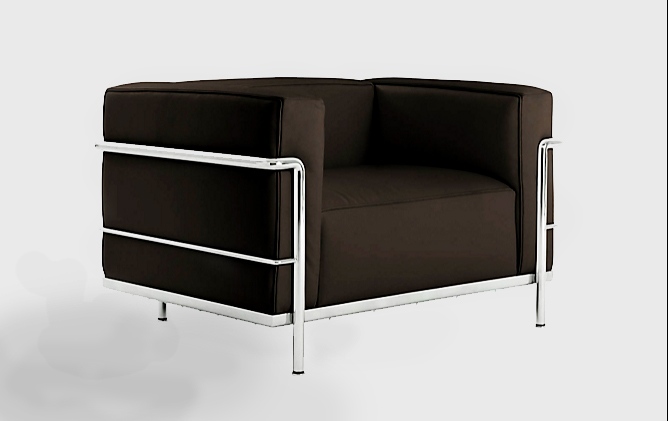
LC-2 Grand Confort, Le Corbusier.
The Grand Confort Chair was designed in 1928 by Le Corbusier, his cousin and colleague Pierre Jeanneret, and Charlotte Perriand.
If you're new to modern architecture, Le Corbusier, and this time period, could keep one busy for years of study. Just bookmark this in your brain, we are now very close to the birth of modernism. But for now, let's move on.
Charles-Édouard Jeanneret, also known as Le Corbusier, was born on October 6, 1887. He was a Swiss-French architect, designer, painter, urban planner, writer, and one of the pioneers of modern architecture. His career spanned five decades, and his architectural designs can be found in Europe, Japan, India, and North and South America.
The LC-2, shown above, is fairly cube shaped. There were two other versions named LC-1, and LC-3. The LC-1 was an open-armed chair and the LC-3 was lower and wider than the LC-2.
Wassily Chair by Marcel Breuer
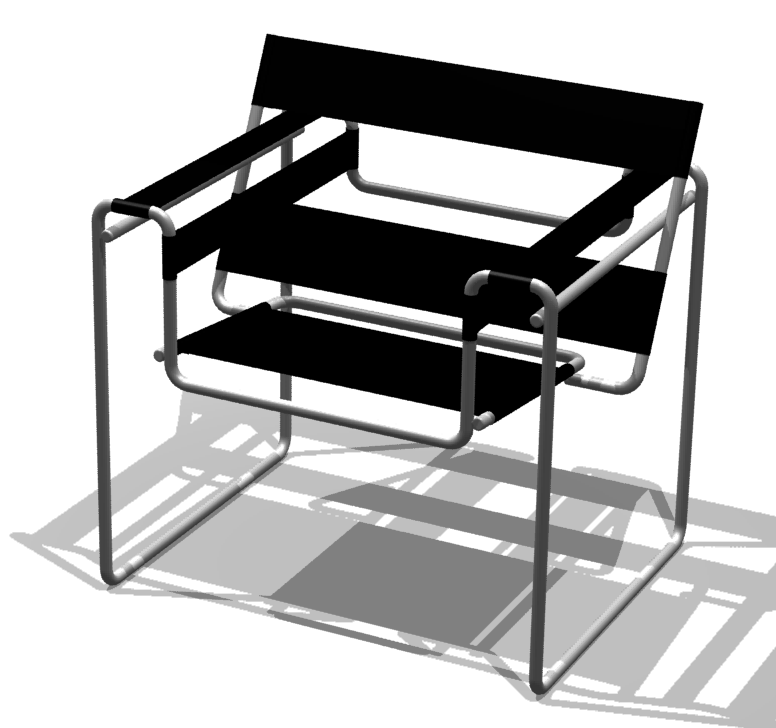
Wassily Chair by Marcel Breuer. Credit: Public Domain
The Wassily Chair, also known as the Model B3 chair, was designed by Marcel Breuer in 1925-1926 while he was the head of the cabinet-making workshop at the Bauhaus, in Dessau, Germany.
Breuer was fascinated by new technology that allowed seamless tubing to be bent. Breuer applied the manufacturing technique to furniture design. It might not seem all that groundbreaking to us today however at the time furniture design was extremely bulky and heavy. The light weight tubing was visually lighter (less mass) and it could be easily mass produced.
The Wassily chair got its name decades later when Italian manufacturer Gavina learned that Breuer made a copy of the chair for artist Wassily Kandinsky. Kandinsky taught at the Bauhaus school of art and architecture from 1922 to 1933.
Iconic Chairs of the 1970s and Beyond
It just seems that good modern furniture design faded away after the 1960s. However, Hans Wegner continued to produce great designs.
It is probably why these famous chair designs are still popular today.
I want to also note that Eero Aarnio, creator of the Ball chair, is alive and well today, and is still active in design.